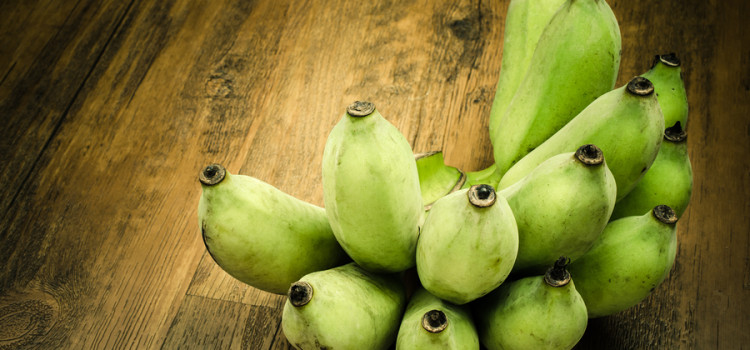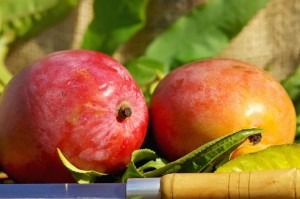Green Banana vs. Yellow Banana – Which is the Better Banana?
Ask most people, “Are bananas good for you?” You’ll most likely get an enthusiastic “yes” for a reply. However, if you ask the question, “Are green bananas good for you?” you may get some looks of confusion.
As children, many of us were told not to eat unripe fruit, but some of those old wives tales are being exposed as being false today. The fact is, a green banana is fine to eat and it has health benefits that a yellow banana does not contain.
But now the question, which is the better banana? Let’s take a closer look shall we?

Benefits of the Yellow Banana
A ripened banana has many nutrients inside. In fact, it contains magnesium, potassium, vitamins, phosphorus, and lots of fiber. You receive a significant number of antioxidants which help with body’s cells fight off the ravages of aging[1].
Bananas may help to fight off certain kinds of cancer. A 2005 study in Sweden showed that fruits and vegetables (bananas included) may reduce the risk of developing kidney cancer. In fact, of all the fruits and vegetables used in the study, bananas showed the most impressive results[2].
Taste and texture are important factors to consider, too. After all, one is more likely to eat something that tastes good. A ripe yellow banana is sweet, soft, and has a pleasant taste.
Downsides of Yellow Bananas
There are not many bad things to say about a yellow banana. However, during the ripening process a few nutrients are lost. Plus, ripe bananas are moderately high on the glycemic index, and diabetics need to avoid too many sources of simple sugars, each day.
Good Things about the Green Banana
When you pick up a bunch of green bananas in the grocery store, they are ‘mature’ and often not completely green. In fact, they are generally picked at about ¾ of their peak ripeness[3]. Otherwise, by the time they got to the retail store, they would be rotten.
As a banana ripens, its ‘resistant’ (complex) starches are slowly turned into sugar, so when eaten green you get a great deal more resistant starch and less sugar. This is good news for people with high blood sugar, because your body has to break down the starches to turn them into sugar (glucose) and as a result, blood sugar levels rise more slowly[4]. Also, green bananas will make you feel full quickly, due to the starch.
Not so Good Things about Green Bananas
Nothing is perfect, and you may notice that a green banana is not as tasty as a yellow one. Green bananas also may cause flatulence in some people. You may not receive as many antioxidants as you would with ripe bananas either.
Which is Best?
Are bananas good for you? Of course they are, and it doesn’t matter if you eat a green banana or a yellow banana. However, if you don’t mind the taste, you want to keep blood sugar levels down and eat less, then go green. In fact, you may want to try both green and yellow bananas, as they have the same amount of calories.
Get straight answers on 5 foods that are stopping you from losing weight
References:
[1] USDA. (n.d.). National Nutrient Database for Standard Reference Release 27. Retrieved 04 07, 2015, from United States Department of Agriculture, Agricultural Research Service
[2] Rashidkhani B1, L. P. (2005, Jan 20). PubMed. Retrieved 4 7, 2015, from US National Library of Medicine National Institutes of Health
USDA. (n.d.). National Nutrient Database for Standard Reference Release 27. Retrieved 04 07, 2015, from United States Department of Agriculture, Agricultural Research Service
[3] Morton, J. (1987). Banana. Retrieved from Purdue Agriculture
[4] (Robertson MD1, B. A. (2005, Sept). PubMed. Retrieved 4 7, 2015, from US National Library of Medicine National Institutes of Health




Is an avocado considered a fruit?
How do you cut an avocado?
Hi, Allen0580. An avocado is technically a fruit, but nutritionally it is more like a fat – that’s how we use it in this program. To cut an avocado, follow these steps:
1. Cut the avocado in half.
•Using a sharp knife, slice through the avocado lengthwise until you feel the knife hit the pit.
•Then rotate the avocado, keeping the knife steady, to make a cut all around the pit.
•Twist the two halves apart (it’s safest to do this on a cutting board).
•Remove the pit.
2. If dicing, score the flesh of the avocado without piercing the skin.
Use your knife’s tip to score avocado flesh, making squares, then scoop it out with a spoon.
3. If slicing, scoop out and slice.
•For neat slices, use your spoon to loosen skin all the way around, and scoop out the flesh whole. •Place flat side down on cutting board and slice using the tip of your knife.
For your recipes is it possible to have the regular diet and gluten free both? My husband and I both have health issues and he will not eat gluten free with me. We appreciate your help.
Hi, Karen. Not all recipes require gluten, and so if they don’t contain it, they aren’t the same sort of “gluten-free” to which I think your husband is referring. As for the rest of the recipes that do not have “gluten-free” in the name, we definitely make an effort to offer both options.
My hubby as well.. When he does pasta (at least 3 times a week or he pouts) I do jasmine rice, spaghetti squash, zucchini, or potatoes they can cook in about the same time as the noodles (I also can’t do fermentable starches, and alot of the gluten free products have them so I can’t do the gluten free bread, pastas, anything with any of the “gum”s in them, etc very often.) I make sure the pasta sauce is gluten free (that he doesn’t even know) and instead of using the frozen meatballs (which usually have gluten in them) i just do ground beef which he is good with. I also keep frozen fish filets in the freezer.. If he insists on Mac and cheese, I just do a filet and a potato and we both do the vegies. It does take a little more time, but isn’t as bad as i thought it would be.